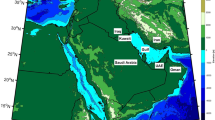Abstract
Solar radiation is an important driving force for the formation and evolution of climate system. Analysis of change in solar radiation is helpful in understanding mechanism of climate change. In this study, the temporal and spatial variations of solar radiation and the cause of the change in solar radiation have been analyzed based on meteorological data from 46 national meteorological stations and aerosol index data from TOMS over the Haihe River Basin and surrounding areas. The results have shown that solar radiation and direct radiation significantly decreased, while scattered radiation increased during the period 1957–2008. Spatially, the decreasing trend of solar radiation was more and more significant from low population density areas to high population density areas. The spatial distribution of increase in aerosol index is consistent with that of decrease in solar radiation. The increase in aerosols resulting from human activities was an important reason for the decrease in solar radiation.
Similar content being viewed by others
References
Abakumova G M, Feigelson E M, Russak V et al., 1996. Evaluation of long-term changes in radiation, cloudiness, and surface temperature on the territory of the former Soviet Union. Journal of Climate, 9: 1319–1327.
Allen R G., Pereira L S, Raes D et al., 1998. Crop evapotranspiration: Guidelines for computing crop requirements. Irrigation and Drainage Paper No.56, FAO, Rome, Italy.
Committee of China’s National Assessment Report on Climate Change, 2007. National Assessment Report on Climate Change. Beijing: Science Press, 60–71. (in Chinese)
Ertekin C, Yaldiz O, 1999. Estimation of monthly average daily global radiation on horizontal surface for Antalya, Turkey. Renew Energ., 17: 95–102.
Hsu N C, Herman J R, Bhartia P K et al., 1996. Detection of biomass burning smoke from TOMS measurements. Geophysical Research Letters, 23: 745–748.
IPCC, 2007. Climate Change 2007: The Physical Science Basis. Cambridge: Cambridge University Press, 1–860.
Kendall M G, 1975. Rank Correlation Measures. London: Charles Griffin.
Liepert B G, 2002. Observed reductions of surface solar radiation at sites in the United States and worldwide from 1961 to 1990. Geophysical Research Letters, 29(10): 1421, doi: 10.1029/2002GL014910.
Mann H B, 1945. Non-parametric tests against trend. Econometrica, 13: 245–259.
Roberto R, Renzo R, 1995. Distributed estimation of incoming direct solar radiation over a drainage basin. Journal of Hydrology, 166: 461–478.
Stjern C W, KristjÃnsson J E, Hansen A W, 2009. Global dimming and global brightening: An analysis of surface radiation and cloud cover data in northern Europe. International Journal of Climatology, 29(5): 643.
Streets DG, Wu Y, Chin M, 2006. Two-decadal aerosol trends as a likely explanation of the global dimming/brightening transition. Geophysical Research Letters, 33, L15806, doi: 10.1029/2006GL026471.
Torres O, Bhartia P K, Herman J R et al., 2002. A long-term record of aerosol optical depth from TOMS observations and comparison to AERONET measurements. J. Atmos. Sci., 59(1): 398–413.
Yue S, Wang C Y, 2002. Applicability of prewhitening to eliminate the influence of serial correlation on the Mann-Kendall test. Water Resource Research, 38(6): 1–4.
Zeng Yan, Qiu Xinfa, Pan Aoda et al., 2008. Distributed modeling of global solar radiation over rugged terrain of the Yellow River Basin. Advances in Earth Science, 23(11): 1185–1192. (in Chinese)
Zheng H, Zhang L, Liu C et al., 2007. Changes in stream flow regime in headwater catchments of the Yellow River basin since the 1950s. Hydrol. Process., 21: 886–893, DOI: 10.1002/hyp.6280.
Zheng H X, Liu X M, Liu C M et al., 2009. Assessing the contribution to pan evaporation trends in Haihe River Basin, China. Journal of Geophysical Research (Atmospheres), 114, D24105, doi: 10.1029/2009JD012203.
Author information
Authors and Affiliations
Corresponding author
Additional information
Foundation: National Key Basic Research Development Program of China, No.2006CB403407; Support Program of the Ministry of Science and Technology, No.2007BAC03A11
Author: Liu Changming, Academician
Rights and permissions
About this article
Cite this article
Liu, C., Liu, X., Zheng, H. et al. Change of the solar radiation and its causes in the Haihe River Basin and surrounding areas. J. Geogr. Sci. 20, 569–580 (2010). https://doi.org/10.1007/s11442-010-0569-z
Received:
Accepted:
Published:
Issue Date:
DOI: https://doi.org/10.1007/s11442-010-0569-z




